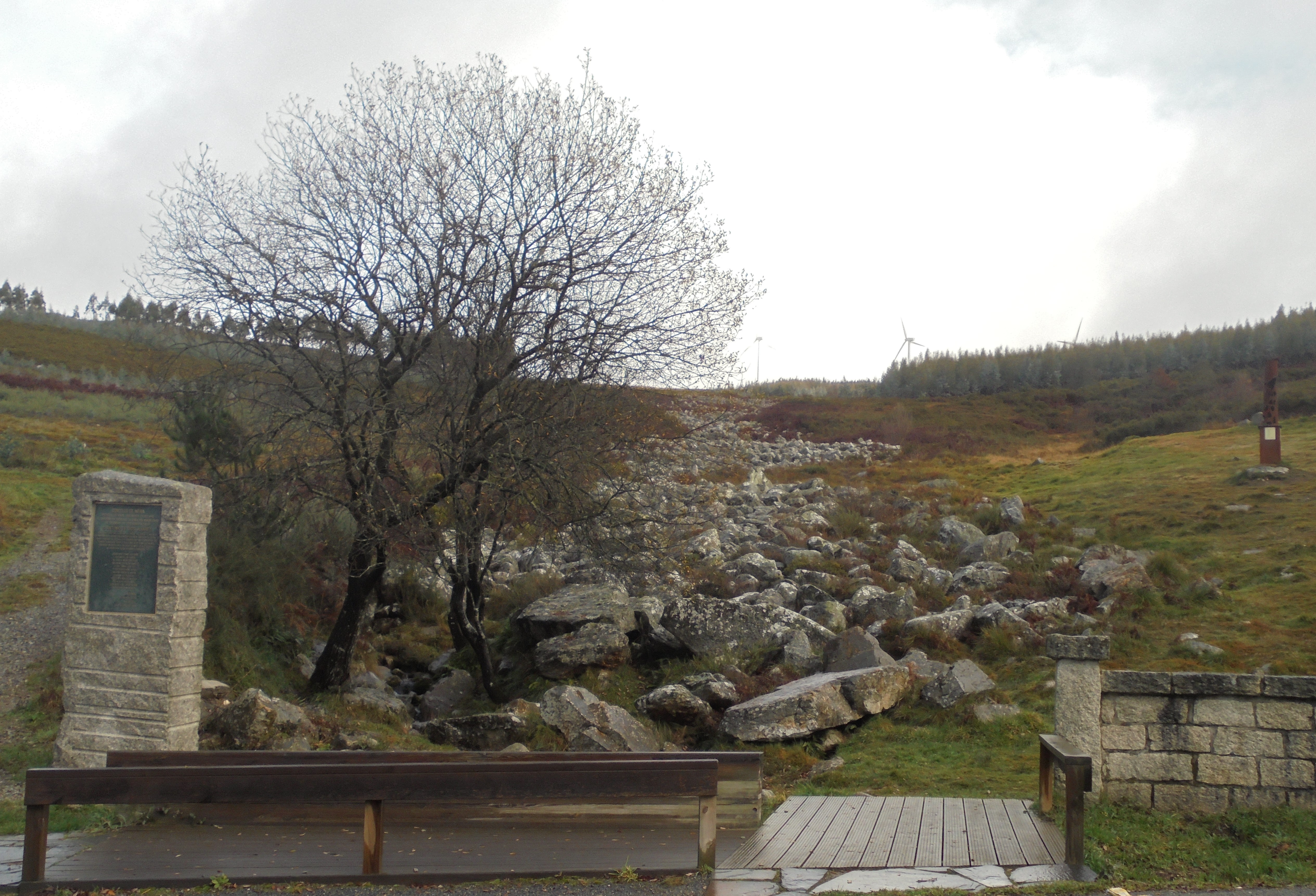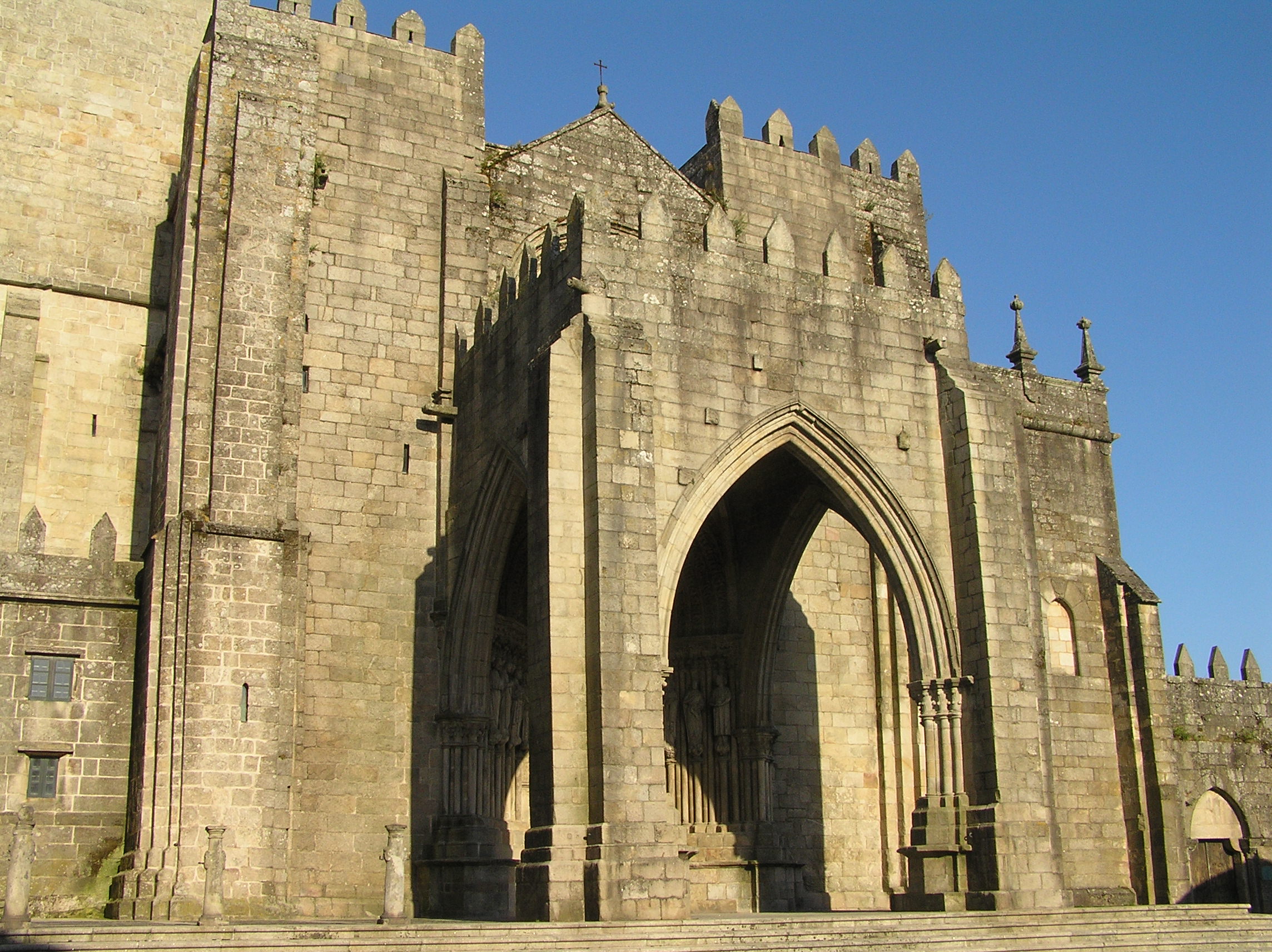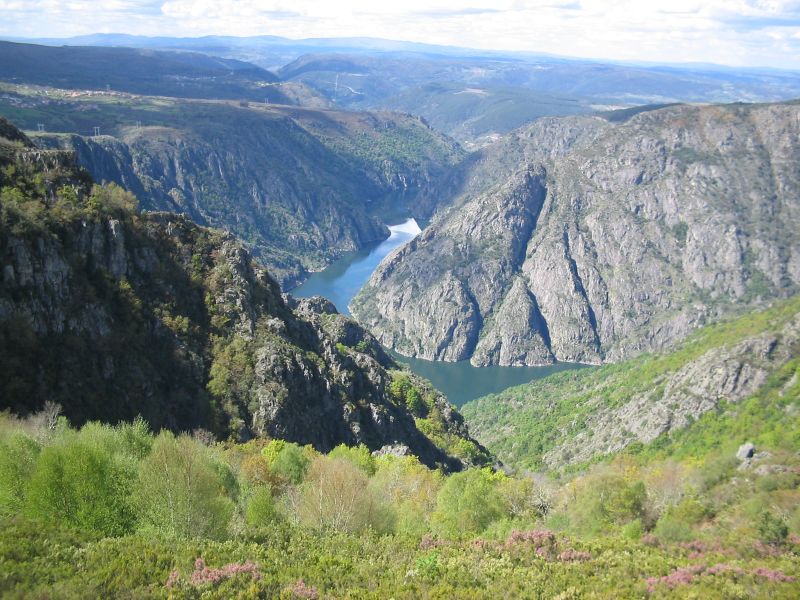|
Minho River
The Minho ( , ) or Miño ( , , ; cel-x-proto, Miniu) is the longest river in Galicia, sharing the border with Portugal, with a length of . By discharge, it is the fourth river of the Iberian peninsula, after the Douro, Ebro, and Tagus. The Minho waters vineyards and farmland, is used to produce hydroelectric power, and also delineates a section of the Spanish–Portuguese border. In ancient English maps, it appears as Minno. The source of the Minho lies north of Lugo in Galicia, in a place called ''Pedregal de Irimia''. After about , the river passes just south of the walls of this old Roman city, discharging in average 42 m3/s, and flows south through canyons until the valley widens north of Ourense. The river has been harnessed in reservoirs from Portomarín to Frieira. Along its length, it has the following reservoirs: Belesar with , Peares with , Velle with , Castrelo with and Frieira with . About north of Ourense at Os Peares, the Minho, with a discharge of 102 m ... [...More Info...] [...Related Items...] OR: [Wikipedia] [Google] [Baidu] |
Tui, Galicia
Tui (; Spanish: ''Tuy'') is a municipality in the province of Pontevedra in the autonomous community of Galicia, in Spain. It is situated in the ''comarca'' of O Baixo Miño. It is located on the right bank of the Miño River, facing the Portuguese town of Valença. The municipality of Tui is composed of 11 parishes: Randufe, Malvas, Pexegueiro, Areas, Pazos de Reis, Rebordáns, Ribadelouro, Guillarei, Paramos, Baldráns and Caldelas. Two bridges connect Tui and Valença: Tui International Bridge (known in Portugal as ''Valença International Bridge'' or "Friendship Bridge"), completed in 1878 under the direction of Pelayo Mancebo, and a modern one from the 1990s. Both countries being signatories of the Schengen Treaty, there are normally no formalities in crossing what is the busiest border-point in northern Portugal. History Prehistory The Tui area was inhabited since prehistoric times. Evidence of this are the sites found during construction of the highway Vigo-Tui, on the ... [...More Info...] [...Related Items...] OR: [Wikipedia] [Google] [Baidu] |
Portomarín
Portomarín is a municipality in the Spanish province of Lugo. It has a population of 2008 (Spanish 2001 Census) and an area of 115 km². It is located on the pilgrimage route known as the French Way of the Camino de Santiago. The town of Portomarín was constructed and built next to a Roman bridge over the Minho River and rebuilt in the Middle Ages. New village In the 1960s the Miño River The Minho ( , ) or Miño ( , , ; cel-x-proto, Miniu) is the longest river in Galicia, sharing the border with Portugal, with a length of . By discharge, it is the fourth river of the Iberian peninsula, after the Douro, Ebro, and Tagus. The Min ... was dammed to create the Belesar reservoir, putting the old village of Portomarín under water. The most historic buildings of the town were moved brick by brick and reconstructed in the new town, including its castle-style main church: Church of San Juan of Portomarín. In the seasons when the dam is at low level, the remains of ... [...More Info...] [...Related Items...] OR: [Wikipedia] [Google] [Baidu] |
Arbo, Pontevedra
Arbo is a municipality in Galicia, in the province of Pontevedra Pontevedra (, ) is a Spanish city in the north-west of the Iberian Peninsula. It is the capital of both the ''Comarca'' (County) and Province of Pontevedra, and of the Rías Baixas in Galicia. It is also the capital of its own municipality whi .... References Municipalities in the Province of Pontevedra {{Galicia-geo-stub ... [...More Info...] [...Related Items...] OR: [Wikipedia] [Google] [Baidu] |
Monção
Monção () is a municipality in the district of Viana do Castelo in Portugal. The population in 2011 was 19,230, in an area of 211.31 km2. The current Mayor is the Social Democrat António Barbosa. The municipal holiday is March 12. Climate Monção has a Hot-summer Mediterranean climate (Köppen: ''Csa'') with mild, rainy winters and hot dry summers, although short, the dry season is dry enough to avoid being classified has a humid subtropical climate or an oceanic climate like nearby Vigo. Notable people * Joaquim Pereira Pimenta de Castro (1846 in Pias, Monção – 1918) an army officer and politician; 10th Count of Pimenta de Castro * José Gomes Temporão (born 1951) a Brazilian public health physician and Minister of Health of Brazil, 2007 to 2010. * Fernando Vilar (born 1954 in Lara, Monção) a Uruguayan journalist and news anchor. Population Parishes Administratively, the municipality is divided into 24 civil parishes (''freguesias''): * Abedim * Anhões ... [...More Info...] [...Related Items...] OR: [Wikipedia] [Google] [Baidu] |
Albariño
Alvarinho () or Albariño () is a variety of white wine grape grown in Northwest Portugal (Monção and Melgaço) and Galicia (northwest Spain) where it is also used to make varietal white wines. In Portugal it is known as Alvarinho, and sometimes as Cainho Branco, Albariño is the Galician name for the grape. It was presumably brought to Iberia by Cluny monks in the twelfth century but recent studies point to Alvarinho/albariño being native to Portugal/Galicia. Both the Portuguese "Alvarinho" and Galician name "Albariño", derive from ''albo''<''albus'', meaning "white, whitish". It has locally been thought to be a clone originating from the region of |
Melgaço, Portugal
Melgaço () is a municipality in Viana do Castelo District in Portugal. The population in 2011 was 9,213, in an area of 238.25 km². It is the northernmost municipality in Portugal. The present Mayor is Manoel Batista, elected by the Socialist Party. The municipal holiday is Ascension Day. History Parada do Monte, Gave and the plateau of Castro Laboreiro were locations of many megalithic burial mounds and graves that suggest the presence of human settlement in the mountains of the region. Alongside is the hilltop castle, that stood firm during the Galician-Leonese battles. Over the streams they built bridges in solid masonry, while dozens of fishing villages sprung from the banks of the River Minho, in addition to the Romanesque convents, churches and chapels, some of which are quite Romanesque. Oral tradition suggest that the castle of Melgaço was constructed during the reign of King D. Afonso Henriques, around 1170. It was this monarch that conceded to Melgaço the first f ... [...More Info...] [...Related Items...] OR: [Wikipedia] [Google] [Baidu] |
Ribeiro (DO)
Ribeiro is a Spanish Denominación de Origen Protegida (DOP) (''Denominación de Orixe Protexida'' in Galician) for wines located in the northwest of the province of Ourense ( Galicia, Spain), in the valleys formed by the rivers Miño, Arnoia, and Avia. It has an area of 30 km2 including 9 municipalities in their entirety and parts of four others. History Ribeiro has a long tradition of producing and exporting wine from the Galician Atlantic ports. It is believed that the first vineyards were planted by the ancient Romans. From the Middle Ages up to the 18th century, the area was renowned for its sweet wines (''vinos tostados''), which were produced here long before they were produced in the Canary Islands or in Andalusia. They were made from sun-dried grapes and were known as ''Ribadavia''. They were drunk by the pilgrims passing through the area on their way to Santiago. Significant quantities of white fortified ''Ribadavia'' wines were exported to England in the 17 ... [...More Info...] [...Related Items...] OR: [Wikipedia] [Google] [Baidu] |
Sil (river)
The Sil is a river in León (Castile and León) and Galicia, Spain, a tributary of the Miño. Its total length is . The source of the Sil is in the Cantabrian Mountains in the Leonese town of Villablino. It flows through the provinces of León and Ourense. The largest city on the Sil is Ponferrada (León). The Sil flows into the Miño upstream from Ourense. Mouth The river joins the Miño river in Os Peares, in the province of Ourense. Generally, the hierarchy between rivers is performed by taking into account which junction has more volume and length. In this case, as with the Esla and Pisuerga with the Duero, the Sil has flows larger than the Miño at the junction. There is a saying that goes, "The Miño has the fame, but the Sil gives it water" (in Spanish, ''El Miño lleva la fama y el Sil le da el agua''). The Sil river also surpasses the Miño in length by about . Course The Sil runs through the León districts of Babia, Laciana, El Bierzo and La Cabrera, and Oure ... [...More Info...] [...Related Items...] OR: [Wikipedia] [Google] [Baidu] |
Velle Reservoir
Velle may refer to: Places * Velle, Møre og Romsdal, a village in Ørsta municipality in Møre og Romsdal county, Norway * Velle, Trøndelag (also Velde or Vellamelen), a village in Steinkjer municipality in Trøndelag county, Norway * Velle, Rogaland, a village in Karmøy municipality in Rogaland county, Norway * Velle reservoir, a reservoir on the Minho River in Galicia, Spain * Velle-le-Châtel, a commune in Haute-Saône department, France * Velle-sur-Moselle, a commune in Meurthe-et-Moselle department, France People *Gaston Velle (1868–1953), a French filmmaker * Marit Velle Kile (born 1978), a Norwegian actress appearing in film and television * Weiert Velle (1925–2007), a Norwegian veterinarian * William E. Tou Velle (1862–1951), a United States Representative from Ohio * Velle Kadalipp (born 1963), an Estonian architect Other * ''Velle'' (film), a 2021 Hindi-language crime comedy film *Velle derrick A derrick is a lifting device composed at minimum ... [...More Info...] [...Related Items...] OR: [Wikipedia] [Google] [Baidu] |




